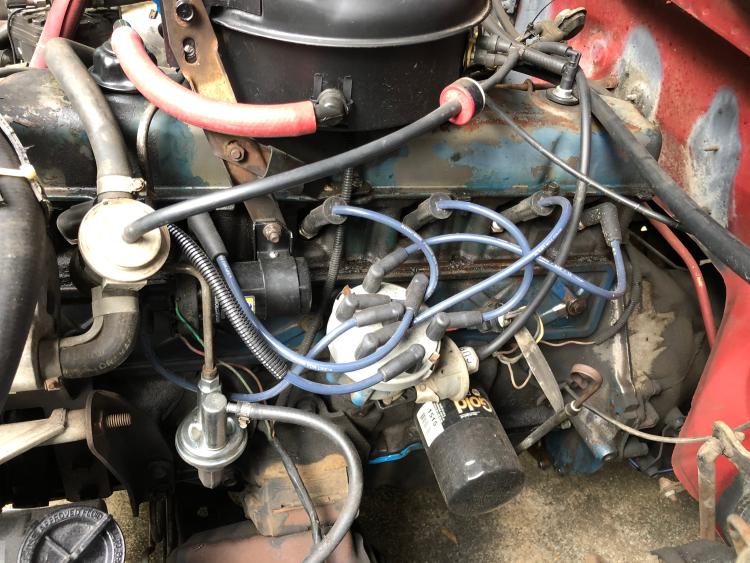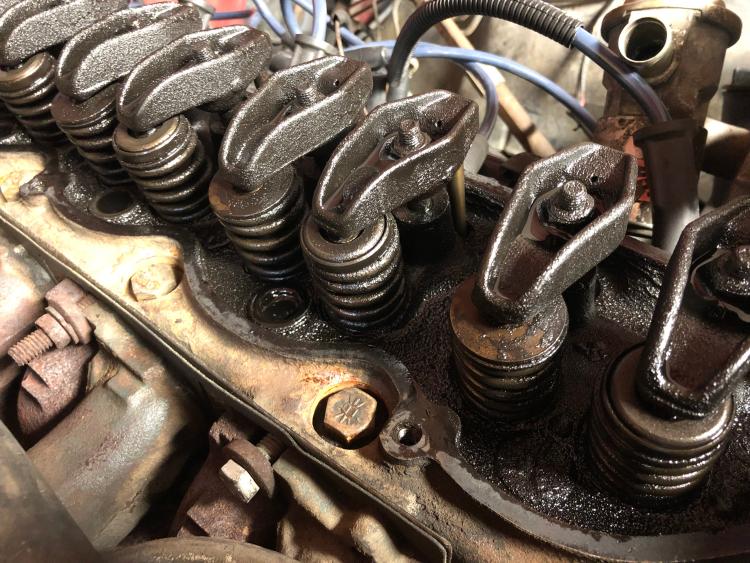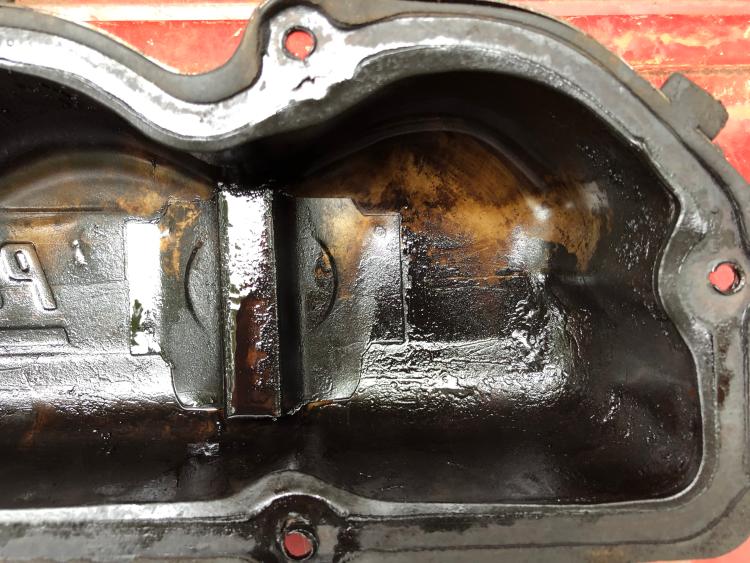The Truck of Doom: An Occasional Build Thread
Re: The Truck of Doom: An Occasional Build Thread
|
Administrator
|
I would never hire a job like that out.
Just get a reman head, and swap this one for core.... Use a piece of clothes line. You never have to worry about losing pressure. I have both C frame and lever type spring compressors. You need the lever style to replace seals, as you want to do.
Jim,
Lil'Red is a '87 F250 HD, 4.10's, 1356 4x4, Zf-5, 3G, PMGR, Saginaw PS, desmogged with a Holley 80508 and Performer intake. Too much other stuff to mention. |
|
In reply to this post by Gary Lewis
I hadn't considered the possibility of the valve guides...but with 'only' 135K miles on the engine, surely they wouldn't be worn out, would they? With the engine having sat mostly unused for 14 straight years, though, I can definitely see the seals being shot. And there's the 'compelling reason' I was looking for; I am most certainly NOT removing the head from the engine. I didn't realize that was the difference between the tool types, although since you've mentioned it it's pretty obvious. I've considered it, but I'm a little leery of sticking things in holes where they don't belong (my mother continually warned me about stuff like that...she was in public health, so you can guess she wasn't referring to trucks), so I'll probably pass. Plus my air compressor is literally three feet away from the truck... |
Re: The Truck of Doom: An Occasional Build Thread
|
Administrator
|
The guides may be worn, but new seals can certainly help with the oil running down the guides during long rests. And, there may be a bit of smoke when you coast, which creates high vacuum in the cylinders and sucks oil in. But, that's probably getting burned up in the catalytic converter as it'll be hot after running a few minutes.
So I'd replace the seals and not worry about the guides unless you have other problems.
Gary, AKA "Gary fellow": Profile
Dad's: '81 F150 Ranger XLT 4x4: Down for restomod: Full-roller "stroked 351M" w/Trick Flow heads & intake, EEC-V SEFI/E4OD/3.50 gears w/Kevlar clutches
|
Re: The Truck of Doom: An Occasional Build Thread
|
Administrator
|
Which may include a coked up Cat if it keeps getting oiled before the Catalytic converter is up to temperature. I don't have one, so I don't worry about leaded fuel or ZDDP in my oil, but if I DiD have one and I still had to get 'sniffed' each year, I'd consider it. IDK what a reman head for a 300 costs, but I bet the Cat is close to $200 (that you wouldn't have to replace IF the head wasn't oozing. You can check guides with the springs off. (well, you can if you use clothesline, and back off enough to wiggle the valve stem around)
Jim,
Lil'Red is a '87 F250 HD, 4.10's, 1356 4x4, Zf-5, 3G, PMGR, Saginaw PS, desmogged with a Holley 80508 and Performer intake. Too much other stuff to mention. |
Interesting...it might be worth disregarding my mother's wisdom and giving this a try on just one cylinder to begin with. Is this a case where if you can feel it wiggle in the bore it's too worn, or does a more sophisticated measurement have to be made? For the record...I do have a cat, but I don't have to get emissions checked. |
Re: The Truck of Doom: An Occasional Build Thread
|
Administrator
|
I'm sure there ARE numbers on play and concentricity....
For me, any appreciable play at the valve stem tip is too much. You need to feel the oil film getting out of the way but if I saw a total of 1/16 or any more, I'd consider that guide trash.
Jim,
Lil'Red is a '87 F250 HD, 4.10's, 1356 4x4, Zf-5, 3G, PMGR, Saginaw PS, desmogged with a Holley 80508 and Performer intake. Too much other stuff to mention. |
|
So...update time.
I'm doing three separate but related jobs right now: cleaning & repainting the valve and pushrod covers, regasketing/resealing those covers, and replacing the valve stem seals. Today I finished up with the pushrod cover. I got it stripped, primed, and painted yesterday and I thought it came out real nice:  After discovering that my vintage tube of blue RTV was a solid block of rubber, I decided to do a little research before buying some more. I ended up with a tube of Permatex High Tack Gasket Sealant instead - I've never been a fan of RTV; because of how slippery it is, I've had gaskets get out of place without my noticing it in the past, requiring me to go back in afterward. A thin bead of this stuff let me glue my gasket to the inside of the cover, and another thin bead smeared across the other side of the gasket let me glue the whole assembly to the engine block without problem, even to the point of staying in place on its own while I futzed with the bolts and bushings. I got it all snugged down, gave it a few hours to set up, then went for a test drive. When I got home the outside of the engine was dry as a bone, so for now I'm happy. I'm curious if other people have used this, and if so what your experience was.  Now that the truck is back in the garage (I also pressure washed the engine again (above is a photo from after the first wash, but before the second), and since I had the plug wires and coil off for that I just kept going and did the pushrod cover in the driveway. If I'd been thinking I'd have gotten it into the garage before doing the cover, but oh well) I can start on the valve cover. Hopefully tomorrow I'll get that off, maybe start on the stripping, cleaning, and painting, and start exploring what lies beneath. The last time I was in there was 2011 or so, and there was a LOT of sludgy buildup. Since then I've been dumping Seafoam into my oil occasionally over the years, and I'm hoping that a lot of that buildup has since dissolved away. If it has, great, and if not, well, I'll have some cleanup to do while I'm in there. |
Re: The Truck of Doom: An Occasional Build Thread
|
Administrator
|
LOL! I was outside the other day placing tape over the openings in the transmission cover on Big Blue and then it hit me - this thing isn't even bolted on! I carried it out here in the 100 degree heat and am taping it when I could have done it inside!
 So, welcome to my world. I haven't used that particular sealant, but have used Indian Head that works somewhat similarly. And for gaskets like you are doing it works quite well. But, it eventually sets up where that stuff doesn't. I think you've found something very nice.  On the sludge, be careful. You'll meet David/1986F150Six here in a few weeks, and he'll tell you about his experience two years ago coming to the show. His engine had been sludged up when he got the truck and he had been changing oil frequently over the years in the hopes of getting the sludge out. And, he did - on the trip here. It partially blocked the pickup screen on the oil pump and he started losing oil pressure. He turned around about an hour from home and got home but the engine wasn't sounding too good. He and his wife got in her car and came on to the show, and when he got home he had a mechanic friend look into it. Luckily there was no damage, but quite a scare. So hopefully the Seafoam has already cleaned things up and you'll find a spic and span head under that valve cover. What did it look like under the side cover?
Gary, AKA "Gary fellow": Profile
Dad's: '81 F150 Ranger XLT 4x4: Down for restomod: Full-roller "stroked 351M" w/Trick Flow heads & intake, EEC-V SEFI/E4OD/3.50 gears w/Kevlar clutches
|
That's encouraging, thanks.  That's pretty much my nightmare scenario. On the bright side...early 2011 is when I started dumping in the Seafoam. In late 2013 I replaced the oil pan, and as part of that I removed and inspected the oil pump. It didn't show any sign of sludge accumulating on the screen - maybe the Seafoam just hadn't done anything by that point, or maybe the sludge was thoroughly dissolving. Then again, that was six years ago - maybe it's been slowly building up since then and I'm headed for trouble. I'll have to ponder at least temporarily adding in a mechanical oil pressure gauge, just to see what I've got - all I have now is the idiot light.  It looked good. I had the side cover off as well in 2011, and I remember thoroughly cleaning the inside of the cover itself - it's still clean now. The space where the pushrods are is also nice and clean, but I don't recall what the state of that area was before - but I do know I didn't clean it. So...definitely no worse than in 2011, but maybe better? I think the valve cover will tell the tale tomorrow.  |
Re: The Truck of Doom: An Occasional Build Thread
|
Administrator
|
If you didn't have sludge in the pan in 2013, after using Seafoam for a couple of years, I'd bet you don't have sludge. And the fact that the back side of the side cover was clean pretty well confirms that. But, I agree that the valve cover will tell the tale.
 However, it won't hurt to put an aftermarket temp, oil pressure, and voltmeter on it before the trip. That'll give you a lot of peace of mind.
Gary, AKA "Gary fellow": Profile
Dad's: '81 F150 Ranger XLT 4x4: Down for restomod: Full-roller "stroked 351M" w/Trick Flow heads & intake, EEC-V SEFI/E4OD/3.50 gears w/Kevlar clutches
|
Re: The Truck of Doom: An Occasional Build Thread
|
Administrator
|
In reply to this post by Dorsai
Back in the day (decade?) of cork composite gaskets we were taught to glue them to the tin with Indian Head and lightly grease the surface that would meet the casting.
This always seemed to work well on valve covers and stuff where you were in there for an adjustment every few weeks. (Porsche/VW, BMW bikes) The High Tack (in my mind) is only there to hold paper gaskets in place while you struggle with a more complex stack up, that might need helical gears slipped into proper time, or shims swapped for proper mesh. If I wanted a gasket sealant that would never set up, I used Hylomar. If I wanted a case sealant that was fuel & oil proof I used Yamabond, or whatever the equivalent Threebond brand product was.
Jim,
Lil'Red is a '87 F250 HD, 4.10's, 1356 4x4, Zf-5, 3G, PMGR, Saginaw PS, desmogged with a Holley 80508 and Performer intake. Too much other stuff to mention. |
Re: The Truck of Doom: An Occasional Build Thread
|
Administrator
|
And why not Permatex #2? I did many valve cover and pan gaskets with it, and never had leaks. Oddly enough, Permatex says "Suggested Applications: Valve cover gaskets, and oil pan gaskets."

Gary, AKA "Gary fellow": Profile
Dad's: '81 F150 Ranger XLT 4x4: Down for restomod: Full-roller "stroked 351M" w/Trick Flow heads & intake, EEC-V SEFI/E4OD/3.50 gears w/Kevlar clutches
|
Re: The Truck of Doom: An Occasional Build Thread
|
Administrator
|
Over Hylomar?
Probably because I was into Norton's and BSA first, and their manuals recommend the same product as used by Rolls Royce! 😏 I tend to use anerobics to actually make a gasket. (with primerN, or T) depending on what's called for.
Jim,
Lil'Red is a '87 F250 HD, 4.10's, 1356 4x4, Zf-5, 3G, PMGR, Saginaw PS, desmogged with a Holley 80508 and Performer intake. Too much other stuff to mention. |
Re: The Truck of Doom: An Occasional Build Thread
|
Administrator
|
We've hijacked the thread, but....
Yeah, if you are into the Brit bikes you need extremely good sealant. I was into American iron, like Chevrolets & Fords, and a Honda or two. 
Gary, AKA "Gary fellow": Profile
Dad's: '81 F150 Ranger XLT 4x4: Down for restomod: Full-roller "stroked 351M" w/Trick Flow heads & intake, EEC-V SEFI/E4OD/3.50 gears w/Kevlar clutches
|
Re: The Truck of Doom: An Occasional Build Thread
|
Administrator
|
Some of those castings were as pourus as a sponge.
Bake the oil out and then brush Loctite 29000 inside before multiple layers of Glypthal.
Jim,
Lil'Red is a '87 F250 HD, 4.10's, 1356 4x4, Zf-5, 3G, PMGR, Saginaw PS, desmogged with a Holley 80508 and Performer intake. Too much other stuff to mention. |
|
In reply to this post by ArdWrknTrk
The games continue today!
First, a quick reference photo. I like to take lots of pictures before I start tearing things apart, for the inevitable time when I forget how something goes back together. Plus, this will make a nice 'before' image for the valve cover paint job:  And with that out of the way...it's time for the big reveal:  Crusty! Looks a lot like it did in 2011, I'm afraid. *sad trombone* I need to do some more research and find a nice labeled diagram of exactly what I'm looking at here - can anyone tell me what the circular depression in front of each pair of springs is? I hope to God they aren't oil return passages of some kind, because they're all packed solid. I've not probed them yet, for fear of shoving crud further down into the engine if that's what they are. In the meantime, I'm going to start cleaning the valve cover...inside and out:  |
|
I've seen way worse than that. But we'll wait to see what others have to say.
|
Re: The Truck of Doom: An Occasional Build Thread
|
Administrator
|
In reply to this post by Dorsai
Those are screw in core plugs, they are Allen style plugs that take a big Allen wrench to turn. The oil on those engines drains back down the push rod slots.
Bill AKA "LOBO" Profile
"Getting old is inevitable, growing up is optional" Darth Vader 1986 F350 460 converted to MAF/SEFI, E4OD 12X3 1/2 rear brakes, traction loc 3:55 gear, 160 amp 3G alternator Wife's 2011 Flex Limited Daily Driver 2009 Flex Limited with factory tow package Project car 1986 Chrysler LeBaron convertible 2.2L Turbo II, modified A413 |
Re: The Truck of Doom: An Occasional Build Thread
|
Administrator
|
In reply to this post by Dorsai
It doesn't look bad at all. I don't think there's anything to fear.
Gary, AKA "Gary fellow": Profile
Dad's: '81 F150 Ranger XLT 4x4: Down for restomod: Full-roller "stroked 351M" w/Trick Flow heads & intake, EEC-V SEFI/E4OD/3.50 gears w/Kevlar clutches
|
Re: The Truck of Doom: An Occasional Build Thread
|
Administrator
|
In reply to this post by Dorsai
Pffff, have a look at a VAG 1.8t from 20 years ago.
Those things would literally fill their valve covers with paste that looked like black beauty mixed into molasses! And -somehow- they still ran. You'd pull the oil pan off, start scraping and chipping, and flush everything out the bottom with diesel.
Jim,
Lil'Red is a '87 F250 HD, 4.10's, 1356 4x4, Zf-5, 3G, PMGR, Saginaw PS, desmogged with a Holley 80508 and Performer intake. Too much other stuff to mention. |
| Edit this page |

